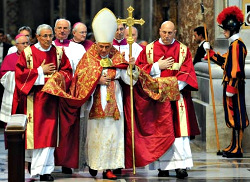
One area of study I have ignored during the 5 years since my conversion is liturgical vestments. There is so much to learn that until now, I have given this area a very low priority. At some point however, in conversation with others, I have to stop describing the things priests or deacons wear and use their actual names. It gets to be embarrassing otherwise!
I was going to make some notes for myself, but decided that you might be interested too. Hence, this post. Please note that this is only the basics. There is a huge amount of variety by rite and somewhat by country and diocese. Proper vesting also varies by rank (for lack of a better word, e.g. priest, monsignor, bishop, archbishop, cardinal, pope) and by ceremonial usage. This should cover most common usage that you will see in your US Latin Rite parish.
Alb
The basic building block of the vestments is the alb (meaning “white” from the Latin Albus). It is that white, floor-length tunic which is under the other parts. It looks like this:
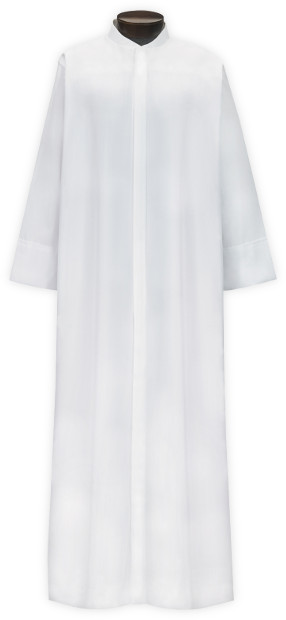
The Alb
The alb is worn by priests, deacons and lay ministers. It is derived from the ordinary clothing of Romans in the first century.
A shorter version of the alb is the surplice, plain or adorned by lace. You might recognize it worn over a black cassock (see next) in choir dress or by seminarians at Mass. There are other forms (e.g. rochet for prelates) and usages. It looks like this:

The Surplice
Cassock
Backing up, priests and deacons often wear a black clerical shirt with matching pants, belt, socks and shoes. This dress does not have a fancy name, but is usually referred to as simply “clerics” or “clerical clothing.”
A less common alternative to this is the cassock (meaning “ankle-length garment from the Latin vestis talaris; a/k/a a soutane). Jesuits, for example, wear simple black cassocks. It looks like this:
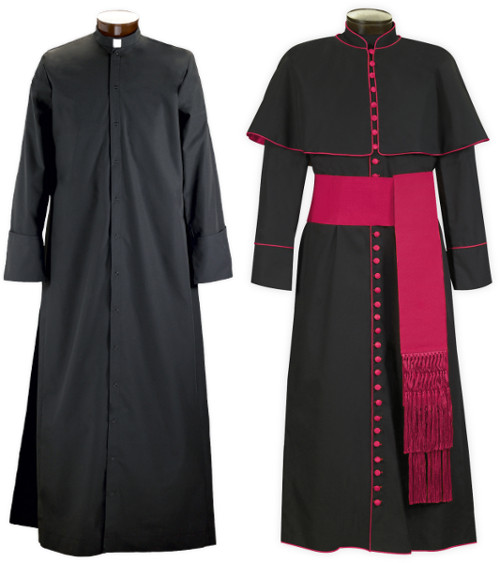
The Cassock (plain and with bishop’s piping, cape and cincture)
Like the alb, the cassock also dates back to first century Roman tunics. It can be black or white (in warm climates) and usually features a built-in collar and top-to-bottom row of buttons (sometimes 33). It may also be worn with a shoulder cape (formally a pellegrina) and colored piping, depending on rank. It can be worn by non-clerics and is the basis for habits worn by the consecrated religious.
Stole
This you quickly recognize. It comes from the Latin stola (meaning “garment”) and is a long wide cloth worn around the neck. Deacons and priests wear it differently, thus:
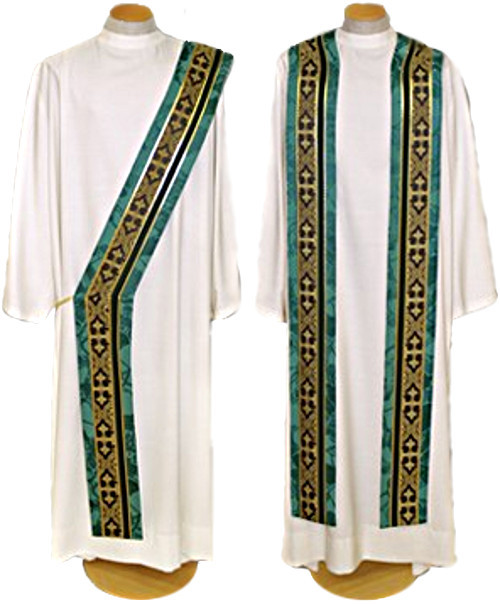
Deacon and Priest Stoles
The stole is worn over the alb (or the shorter surplice, depending on use) and its color matched to the liturgical season, feast or special Mass. It can also be worn over clerics outside of Mass (e.g. a purple stole worn by the priest at confession).
Chasuble
Chasuble (meaning “little house” from the Latin casula) is the outermost body garment. It is layered over the stole and alb. It looks like this:

The Chasuble (for priests)
The chasuble is worn by priests only at Mass or other sacred actions connected to a Mass. It is derived from traveling coats worn at the end of the Roman empire. Like the stole, its color is liturgically keyed.
Dalmatic
Like the chasuble, the dalmatic is worn over stoles and albs. It is similarly ornamented and colored and at a glance may appear to be the same. It’s not and it is important to know the difference because of who wears each. Unlike the chasuble, the dalmatic has wide sleeves, customarily with a slit under each in a scapular style (although not always). Additionally, the dalmatic typically has 2 stripes which run from hem to hem over the shoulders with 2 cross stripes connecting them. It looks like this:
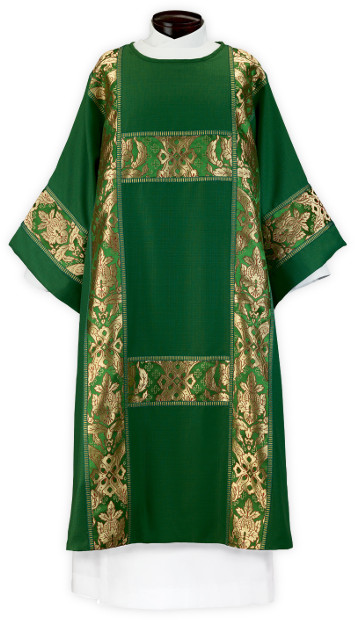
The Dalmatic (for deacons)
While only priests wear chasubles, only deacons wear dalmatics. Except on special uses where a bishop wears a dalmatic under his chasuble (confusing, huh?). One final note, in the Extraordinary Form of the Mass (Tridentine), the dalmatics worn by subdeacons are distinguished from those of deacons by having only 1 cross stripe (vs. 2 for deacons). These dalmatics are also known as tunicles and of course, subdeacons (constituted but not ordained) do not wear stoles under them.
Other Stuff
Cincture
Braided cords, white or keyed to the liturgical color, tied around the waist with knotted or tasseled ends hanging on the side. These can also be wider bands as worn by bishops. It looks like this:

Cincture (around waist)
Cope
Cope (meaning “cape,” from the Latin cappa) is easily recognized as an long cape draped over the shoulders, open in front and worn over other vestments. It looks like this:

The Cope
The cope is worn by priests during special Solemnities and Eucharistic adoration.
Humeral Veil
A special garment worn briefly by priests and deacons during the blessing, while grasping a monstrance at the end of adoration of the blessed sacrament. It looks like this:
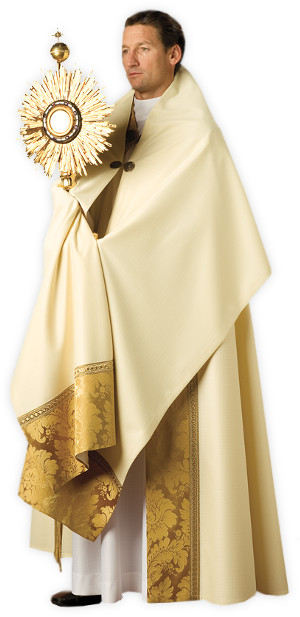
The Humeral Veil
Biretta
A biretta (from the Latin biretum, birretum) is a square cap with 3 “peaks” (in a square, the corner without a peak is worn to the left). They are black (for priests and lower rank), amaranth (reddish rose) for bishops and scarlet red for cardinals. Tufts (poms) are on top except for cardinals. Bishops have purple tufts and some Vatican priests have red tufts, but most are black. It looks like this.

The Biretta
The biretta is worn by all ranks below pope to subdeacons and seminarians.
Bishop Stuff
Mitre
Those “pointy hats” worn by bishops. It looks like this:
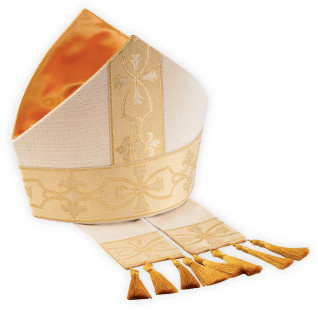
The Mitre
Zucchetto
The skull cap worn by prelates (i.e. pope and bishops). See picture below.
Pectoral Cross
A large cross worn on a chain or cord by bishops. It looks like this:
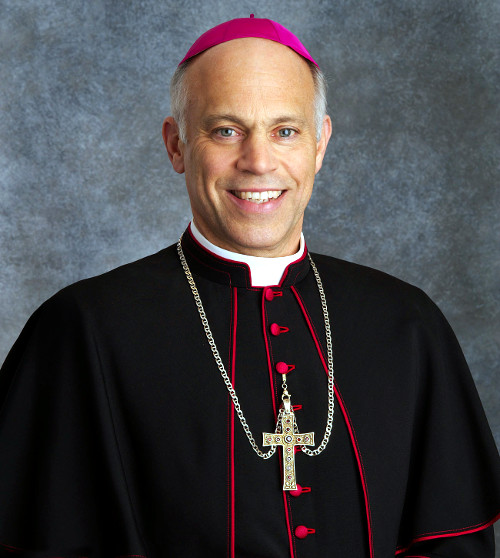
Pectoral Cross and Zucchetto (Archbishop Salvatore Cordileone)
Concluding Notes
This list is not exhaustive, but covers common vestments you will see. Other vestments include the maniple, amice, pallium, ferula, pontifical gloves and sandals, galero, camauro, fanon, mozzetta, papal tiara, subcinctorium, falda, etc. Still other additional vestments apply to Eastern Rite Catholic churches. Much more can be said about each item listed on its use, history and symbolism.
I also did not address in any detail when these vestments can be worn and in what combinations. There is a lot of tradition here and for many cases, the requirements are detailed in the GIRM (General Instruction of the Roman Missal). Some things are debatable (e.g. wearing a maniple in the OF Mass).
Also note that clergy sometime fill a different liturgical role than that of their rank. For example, priests sometimes serve and dress as deacons when they are not concelebrating or deacons in choir dress acting as master of ceremonies. You are most likely to see this kind of thing (when useful, if at all) for a Mass celebrated by your bishop. Generally, if you see someone wearing a chasuble they are a priest; if they are wearing a dalmatic then they are a deacon.
Lastly, this piece did not touch on similarly rich non-vestment liturgical items such as the crucifix (OK, that one is easy), tabernacle, sanctuary lamp (tabernacle lamp), ambo, altar, missal (sacramentary), breviary, lectionary, the Roman Ritual / Roman Pontifical / Roman Martyrology / Roman Gradual, crosier, processional cross, processional candles, paschal candle, font, chalice, ciborium, host, paten, cruets, credence table, thurible (censer) and boat, incense, aspersory and aspergillum (aspergill), monstrance (ostensorium or ostensory) and its luna, pyx, chalice veil, purificatior (mundatory or purificatory), pall, finger towels, corporal, burse, etc. You can see why I didn’t get into all that here!
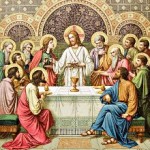


























Share Your Thoughts